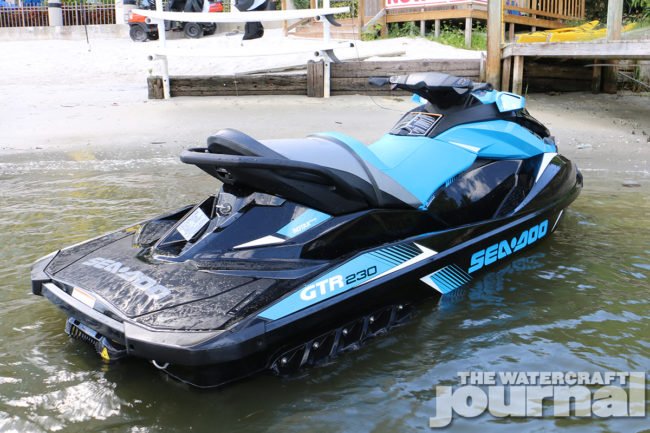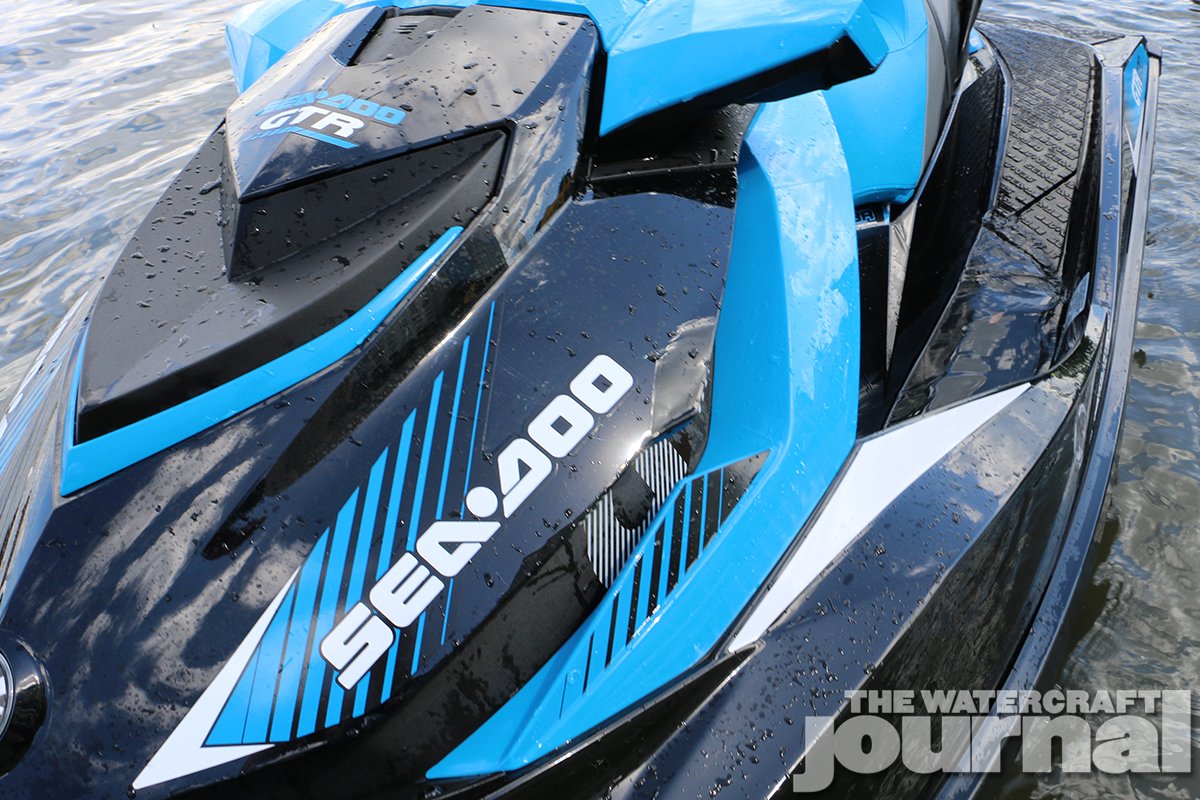
To those regular readers of The Watercraft Journal, you’ll know that we fail pretty regularly to hide our personal bias towards the Sea-Doo GTR. Upon its initial introduction five years ago, the application of Sea-Doo’s supercharged-and-intercooled Rotax 1503 producing a wind-blown-smile-inducing 215-horsepower to the then-newly redesigned GTI platform was a match made in watercraft heaven. Whether you’re a fan of the GTR’s stellar power-to-weight ratio; its jack-of-all-trades hull that can either be loosey-goosey playful or track as straight as an arrow; or its awesomely aggressive angular aesthetic, the GTR has maintained itself as an overall favorite.
For 2017, the Sea-Doo GTR gets a little more than just a new suit of clothes (although the Black & Octane Blue livery is very fetching), but a whole new engine as well. As part of the brand’s eventual phasing out of the previous generation 1503 Rotax 4-tec, replacing it with Rotax’s weight-saving and efficiency-increasing ACE (Advanced Combustion Efficiency) technology, the new 2017 Sea-Doo GTR gets a bump from 215 to 230-horsepower. The increase is much more than just a turning up of the wick, but the by-product of streamlining the engine’s overall effectiveness, resulting in a smoother-operating engine.

The in-line three cylinder plant – christened the 1500 HO ACE – replaces the 1503 215-horsepower Rotax 4-tec, yet maintains the same 1,494cc displacement. In fact, the castings of the crankcase and cylinder case are identical as the outgoing engine as well. The devil, as it were, is in the details, as the 1500 HO shines from its use of a redesigned cylinder head featuring four valves-per-cylinder, an all-new combustion chamber (accounting for the ACE head’s superior quench and distribution), and improved intake and exhaust ports.
Likewise, the new 1500 HO ACE employs Sea-Doo’s new plasma coating (applied to the aluminum casing’s cylinder walls via a proprietary thermal spraying process exclusively developed by Rotax’s team in Gunskirchen, Austria), to replace the heavy steel pressed-in sleeves. This new sleeveless cylinder design not only shaves overall engine weight (totaling 194-pounds), but minimizes friction, improving surface durability and heat transference.

Finally, the new 1500 HO comes equipped with Sea-Doo’s newly redesigned “maintenance-free” supercharger and external intercooler. The re-engineered supercharger uses a revised drive shaft that rides on two composite bearing packs at either end of a machined shaft, similar to its bigger 300-horsepower siblings. And, thanks to BRP’s iControl engine management, the 1500 HO is optimized for either regular or premium fuel, although performance is directly reflected in what you feed it.
And equal all 230 and 260 models, the GTR uses the same 159mm pump to process all of that power into water-spouting thrust. Sharing the pump tunnel is Sea-Doo’s USCG-awarded second generation iBR, which is not only more compact and lighter (weighing approximately 16.4-poounds, including the electronic module and all of the mechanical components) but also allows you to stop nearly 160-feet sooner than a PWC without an on-water braking system (*cough* Kawasaki *cough*). Fuel capacity remains identical at 15.9 gallons, and storage is utilitarian 30.8 gallons.

As noted earlier, the GTR 230 rides atop the same 130.6-inch long hull as the GTI SE 130 and 155, as well as the GTI 155 Limited and GTR-X 230. The mild strakes and low-V hull manages a duality of both stable and true when gliding across glass, or playful and loose when pushed without feeling schizophrenic. Unlike the often too-aggressive RXP-X hull, the GTR 230 can comfortably cruise or sweep a wide turn when called on. Obviously, there is a point in the apex where the 230-ponies will overpower the shallow-V hull, but discovering that is part of the fun. It is meant to be playful after all.
Externally, the GTR 230 retains much more of its DNA with the GTI family than its wild new GTR-X 230 sibling, sharing the same fairings, hood and fixed steering system. Yet, being part of Sea-Doo’s Performance segment affords the machine its VTS (Variable Trim System) handlebar-mounted toggles, the easy-to-navigate LCD and twin dial analog gauge system and info center, and iTC (Intelligent Throttle Control) allowing for quick cycling through Touring, Sport and Eco tunes. The grips are Sea-Doo’s new palm rest variety that can be off-putting at first, but surprisingly effective especially over longer rides.

Priced at $11,999, the 2017 Sea-Doo GTR 230 is noticeably trimmed of fat. No retracting swim step, or X-package digital options (including time/distance to empty, top/average speed/RPM, lap timer and engine temperature in-dash features) come with the Performance segment’s lowest rung – but are available options, as well as a bevy of other items. Now, if you’ve read our reviews on two other of Sea-Doo’s GTI-based machines, the 2017 GTI SE ACE HO 900 and the 2017 GTR-X 230, you’ll know that there are some big changes on the horizon. We’re extrapolating here, but we’re thinking this might be the only year of an all traditional SMC fiberglass GTR before receiving either a new CM-Tech deck or *gasp* a Polytec hull (although we foresee the latter as being a little far fetched for now).
Weighing in at 807-pounds, the GTR 230 actually bests the stylish GTR-X’s power-to-weight ratio .29:1 versus .28:1. It’s not much, but a difference of 14-pounds between the two might make all the difference between a showdown among friends. Throwing objectiveness to the wind, we’ve always expressed a bit of favoritism towards the GTR, and now with a smoother running and more powerful engine, there’s even more reason to praise this little machine. Again, it’ll happily serve double duty as a hot toy or a family craft thanks to its standard Eco mode, so there’s no reason why mom or dad can’t enjoy it.



























